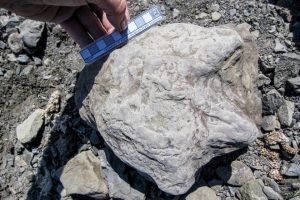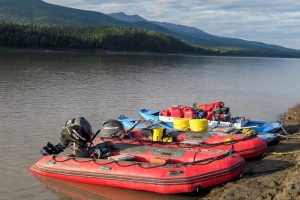Scientists discover dinosaur fossils along Alaska river
Pushing off from the banks of the Tanana River this summer, Pat Druckenmiller knew the challenges his team of scientists would encounter trying to find dinosaur footprints along the banks of the Yukon River.
A long trip with lots of rock hounding awaited, he figured. And for what? Maybe a few footprints here and there.
What the Alaska paleontologist didn’t expect was finding, literally, a ton of dinosaur fossils.
His team of 14 people spent two weeks traveling 500 miles of the Yukon River this summer, and in the process uncovered thousands of dinosaur footprints along the river’s edge.
For Druckenmiller, earth sciences curator for the University of Alaska Museum of the North, the magnitude of the find went far beyond his expectations. On one beach the team collected 50 fossils in 10 minutes.
“It’s a little overwhelming,” he joked in a phone interview Wednesday.
From small dinosaurs to 25-foot-long plant eaters
Druckenmiller said the area — along the banks of the Yukon River between the villages of Ruby and Kaltag — is one of the richest dinosaur fossil sites in Alaska. Fossils of both meat- and plant-eating species were among the finds, ranging up to 25-foot long plant eaters.
Those tracks will help scientists better understand the extent of dinosaurs’ range in Alaska. With other finds on Alaska’s North Slope and in the Denali National Park area, the Yukon River specimens allow scientists to assemble a more-complete picture on which dinosaurs roamed the state — and when.
“One minute they don’t exist on the map, and then there are tons,” he said.
While it’s impossible to determine exactly which species left each fossil (Druckenmiller noted the only true way to know is to find a skeleton at the end of a set of foot prints, an unlikely prospect) the prints can still tell scientists plenty about what kind of animals lived in Interior Alaska 100 million years ago.
“There are not second-class fossils,” he said. “They are just as important.”
Dinosaurs all over Alaska
Often, fossils can be more telling than bones. Space between the prints can show the stride length of the animal. Sometimes fossils also provide better details about the soft tissue of the foot, something that would be lost in a skeleton fossil.
Most of the fossils found were “natural casts,” meaning the fossils are raised, versus being a relief in the rock.
Scientists knew the area had the potential to be a dinosaur gold mine, based on the age of the rocks. But University of Alaska Fairbanks geologist Paul McCarthy said there has been little research on rocks in that location, based solely on the challenges of getting there. Also, there’s been little oil and gas exploration in the area, work that can often uncover fossils.
McCarthy said the find shows that dinosaurs really were all over Alaska, and that he and others are now looking at other sites with rocks of similar age in other parts of the state.
But the odds of finding a similar concentration of fossils? Unlikely — which is what makes the Yukon River site so valuable.
“They were everywhere, you could find them with no effort at all,” McCarthy said. “That, in my experience, is unusual.” He noted that he could hike around looking for tracks in Denali all day and maybe only find 10 to 20.
The Yukon River find was limited to the banks of the river, since Druckenmiller only had permits to look there — a limitation, he noted, that would keep wannabe paleontologists from visiting the area to snag fossils of their own. Druckenmiller hopes to return to the area next summer to explore even further by gaining permission to do research on land that belongs to Alaska Natives.
Contact Suzanna Caldwell at suzanna(at)alaskadispatch.com








